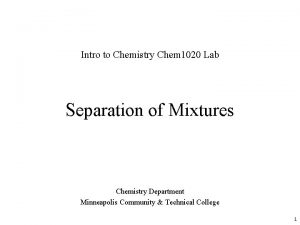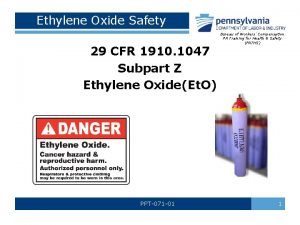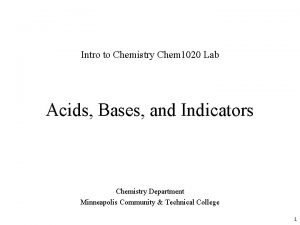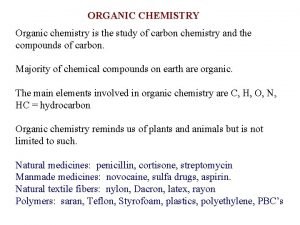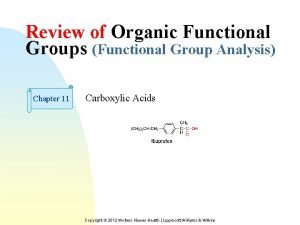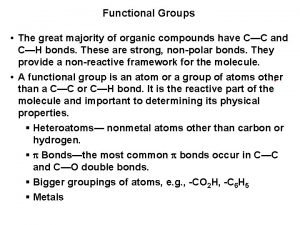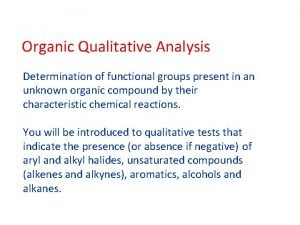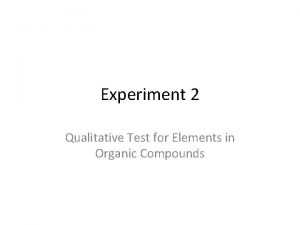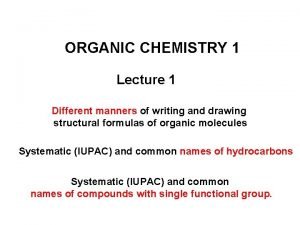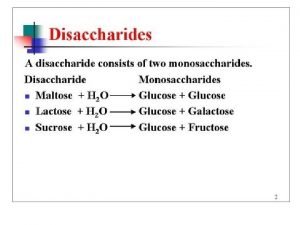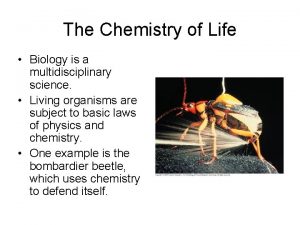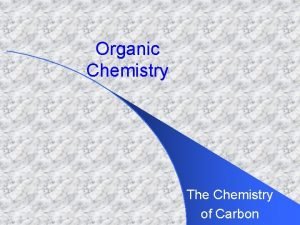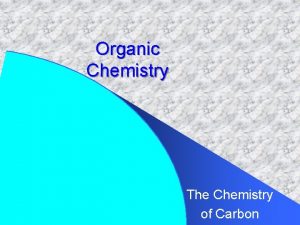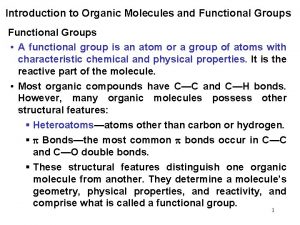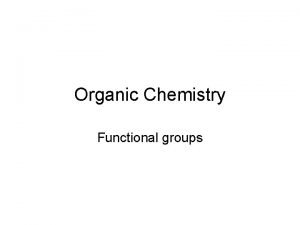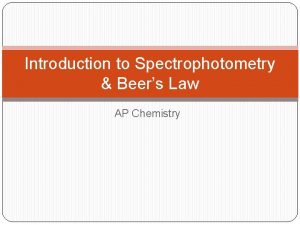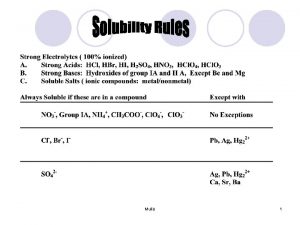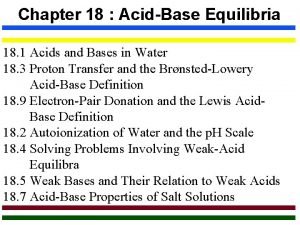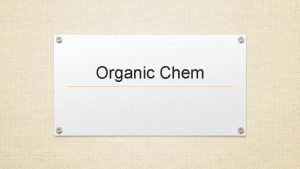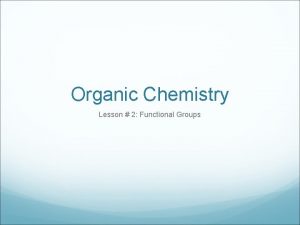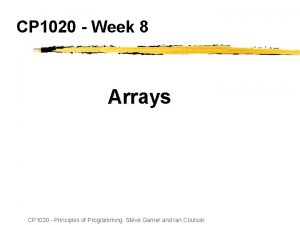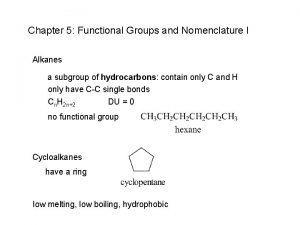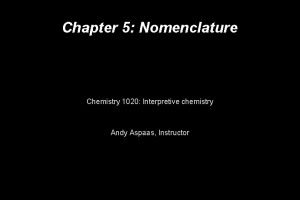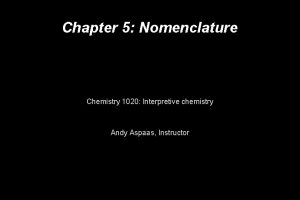CHEM 1020 4242017 Monday FUNCTIONAL GROUPS NOMENCLATURE FUNCTIONAL





















































- Slides: 53

CHEM 1020 4/24/2017 Monday FUNCTIONAL GROUPS & NOMENCLATURE

FUNCTIONAL GROUPS • Functional Groups are unique reactive combinations of atoms that differentiate organic compounds of one class from those of another. • Examples: • Except for alkanes, each functional group contains a multiple bond or at least one oxygen or nitrogen atom.

FUNCTIONAL GROUPS (continued)

REPRESENTING ORGANIC COMPOUNDS • Expanded structural formulas show all the covalent bonds. • Condensed structural formulas show the general arrangement of atoms without showing all the covalent bonds. CH 3 CH 2 CH 3 or CH 3(CH 2)2 CH 3

CLASSIFICATION OF HYDROCARBONS (continued)

ALKANES • Alkanes can be represented by the general formula Cn. H 2 n+2, where the n is the number of carbon atoms in the molecule. • The simplest alkane is methane (CH 4), which is the primary compound in natural gas. • Ethane (C 2 H 6) is a minor component of natural gas. • Propane (C 3 H 8) is used as a fuel for heating homes and cooking.

CONFORMATIONS OF ALKANES (continued) • Which of the following pairs represent structural isomers, and which are simply the same compound? • Which are normal alkanes and which are branched alkanes?

ALKYL GROUPS • An alkyl group is a group differing by one hydrogen from an alkane.

COMMON NONALKYL GROUPS

NAMING ALKANES • The IUPAC method consists of: Root

NAMING ALKANES (continued) • Step 1: Identify and name the longest carbon chain. This gives the root and ending. (The ending –ane signifies the alkane family. ) • Step 2: Number the longest carbon chain to give the lowest number to any carbon to which a group is attached. 5 CH CH 3 | | Example: CH 2 — CH 3 (pentane) 4 3 3 2 1 • Step 3: Locate and name the attached alkyl groups. • Step 4: Combine the longest chain and the branches into the name. 2 -methylpentane

NAMING ALKANES (continued) • Step 5: • For multiple branches, show the location of each branch with numbers. • For multiple branches of the same type, modify the name with di-, tri-, tetra-, penta-, etc. and separate the position numbers by commas. • List multiple branches alphabetically. Ignore the di-, tri-, sec-, and t- prefixes. Example: 1 CH 3— 2 CH — 3 CH — 4 CH — 5 CH 2 — 6 CH 2 — 7 CH 3 | | | CH 3 CH–CH 3 | CH 3 4 -isopropyl-2, 3 -dimethylheptane

THE SHAPE OF CYCLOALKANES

NAMING CYCLOALKANES • Cycloalkanes are alkanes containing rings of carbon atoms. • The prefix cyclo- is used before the alkane name. • When two or more substituents are attached to the cycloalkanes, the ring numbering begins with the first group alphabetically and proceeds to give lowest numbers possible. Example: CH 2 CH 3 1 CH 3 3 2 1 -ethyl-3 -methylcyclopentane

ISOMERISM & CYCLOALKANES (continued) • Two geometric isomers exist for 1, 2 -dimethylcyclopentane. • Cis-substituents are on the same side of the ring. • Trans-substituents are on the opposite sides of the ring.

UNSATURATED HYDROCARBONS • Unsaturated hydrocarbons contain one or more carbon multiple bonds. • Alkenes contain one or more carbon-carbon double bonds (C=C ). • Alkynes contain one or more carbon-carbon triple bonds (C≡C). • Aromatics contain benzene rings.

NAMING ALKENES • Step 1: Name the longest chain that contains the C=C bond. Use the IUPAC root and the –ene ending. • Step 2: Number the longest chain so the carbon atoms joined in the C=C bond get the lowest number possible. • Step 3: Locate the C=C bond with the lower-numbered carbon. Examples: 1 2 3 4 CH 3 -CH=CH-CH 3 2 -butene 6 5 4 3 2 1 CH 3 -CH 2 -CH=CH-CH 3 2 -hexene

NAMING ALKENES (continued) • Step 4: Locate and name attached groups. • Step 5: Combine all the names.

NAMING ALKENES WITH MULTIPLE DOUBLE BONDS • Step 1: Follow the same naming instructions for alkenes with one double bond, except use the endings –diene, – triene, and the like to denote the number of double bonds. • Step 2: Indicate the location of all the multiple bonds. • EXAMPLES:

THE GEOMETRY OF ALKENES (continued) • Because there is no free rotation about the C=C bond, geometric isomerism is possible. • cis- isomers have two similar or identical groups on the same side of the double bond. • trans- isomers have two similar or identical groups on opposite sides of the double bond.

ALKYNE NOMENCLATURE • Alkynes are named in exactly the same ways as alkenes, except the ending –yne is used. • Examples:

NAMING BENZENE DERIVATIVES • Guideline 1: When a single hydrogen attached to the benzene ring is replaced, the compound can be named as a derivative of benzene.

NAMING BENZENE DERIVATIVES (continued) • Guideline 2: Some common names are IUPAC-accepted and used preferentially.

NAMING BENZENE DERIVATIVES (continued) • Guideline 3: When the benzene ring is part of a more complex hydrocarbon, the benzene ring is referred to as a phenyl group.

NAMING BENZENE DERIVATIVES (continued) • Guideline 4: When two groups are attached to the benzene ring, their positions can be designated by the prefixes ortho (o), meta (m), and para (p).

NAMING BENZENE DERIVATIVES (continued) • Guideline 5: When two or more groups are attached, their positions can be indicated by numbering the ring so as to obtain the lowest possible numbers for the attachment positions.

ALCOHOLS, PHENOLS, & ETHERS • A hydroxy group is the –OH functional group. • An alcohol has an –OH group attached to an aliphatic carbon atom. General formula: R-OH • A phenol has an –OH group on a benzene ring. • An ether has the functional group: • Ether general formula: R-O-R’

NAMING ALCOHOLS • Step 1: Name the longest chain to which the –OH group is attached. Use the hydrocarbon name of the chain, drop the final –e, and replace it with –ol. • Step 2: Number the longest chain to give the lowest number to the carbon with the attached –OH. • Step 3: Locate the –OH position. • Example: OH | CH 3—CH 2—CH—CH 2—CH 3 6 5 4 3 2 1 3 -hexanol

NAMING ALCOHOLS (continued) • Step 4: Locate and name any other groups attached to the longest chain. • Step 5: Combine the name and location of other groups, the location of the –OH, and the longest chain into the final name. • Example: CH 3 OH CH 3 | | | CH 3—CH 2—CH—CH 3 6 5 4 3 2 1 2, 4 -dimethyl-3 -hexanol • Note: Alcohols containing two –OH groups are diols, three –OH groups are triols. The IUPAC names for these compounds have endings of –diol and –triol rather than –ol.

NAMING PHENOLS • Substituted phenols are usually named as derivatives of the parent compound phenol. • Examples:

CLASSIFICATION OF ALCOHOLS

NAMING ETHERS • IUPAC name: Name the smaller of the two R groups as an alkoxy group attached to the parent chain by replacing the –yl ending of the R group with –oxy. • Common name: Name the groups attached to the oxygen alphabetically and add the word ether. common: sec-butyl ether

ALDEHYDES AND KETONES • The carbonyl group: • Aldehydes have at least one hydrogen attached to the carbonyl group. • Ketones have two carbons attached to the carbonyl group.

NAMING ALDEHYDES • Find the longest carbon chain that contains the aldehyde group. (The carbonyl carbon is carbon number 1. ) • Change ending of the root hydrocarbon name by dropping –e and adding –al. • All other branches and groups are named and located using standard IUPAC system. • Examples: 3 -bromobutanal 2 -ethylbutanal

NAMING KETONES • Find the longest chain that contains C=O. • Using the root alkane name, drop the –e ending and change to –one. • Number the longest carbon chain so the C=O group has the lowest number. • Name and number other attached groups as before. • Examples: 3 -methyl-2 -pentanone 2 -methylcyclohexanone

ALDEHYDE AND KETONE REACTIONS (continued) • Hemiketal general formula: • Ketal general formula:

ALDEHYDE AND KETONE REACTIONS (continued) • Hemiketal example: • Ketal example:

ALDEHYDE AND KETONE REACTIONS (continued) • Cyclic hemiacetals and hemiketals are more stable than open-chains and are important in carbohydrate chemistry.

CARBOXYLIC ACIDS • The functional group of carboxylic acids is the carboxyl group. • Many carboxylic acids have common names.

CARBOXYLIC ACIDS IUPAC NOMENCLATURE • Find the longest carbon chain that contains the –COOH group. • Drop the –e from the end of the hydrocarbon name and substitute –oic acid. • Number the longest chain. Carbon number 1 is the carboxyl carbon. • Name and number other attached groups. • Examples:

CARBOXYLIC ACIDS IUPAC NOMENCLATURE (continued) • Aromatic acid names are derived from the parent compound, benzoic acid. • Example:

SALTS OF CARBOXYLIC ACIDS (continued) • To name a carboxylic acid salt, name the metal ion first and change the –ic ending of the acid name to –ate. • Example:

CARBOXYLIC ESTERS • The ester functional group has an ester linkage between the carbonyl carbon and the single-bonded oxygen atom.

NAMING ESTERS • The first word of the name of an ester is the name of the alkyl or aromatic group (R') contributed by the alcohol. • The second word is the carboxylic acid name, with the –ic acid ending changed to –ate.

NAMING ESTERS (continued) • Examples: methyl acetate methyl ethanoate phenyl butyrate phenyl butanoate ethyl benzoate

AMINES • Amines are derivatives of ammonia, NH 3, where one or more hydrogen atoms have been replaced by an organic (R) group.

COMMON NAMING FOR AMINES • Alphabetically link the names of the alkyl or aromatic groups bonded to the nitrogen and attach the suffix –amine so the name is one word. • Use di- or tri- prefixes for identical alkyl groups. • Examples:

IUPAC NAMING FOR PRIMARY AMINES • The –NH 2 group is treated as a chain substituent called the amino group. • Examples:

IUPAC NAMING FOR AMINES • Name the longest chain attached to the nitrogen. • Replace the final –e with –amine. • Number the chain so the carbon bonded to the nitrogen has the lowest possible number. • Number the other substituents on the carbon chain. • An italic “N” is used as a prefix for a substituent on nitrogen. • Examples:

NAMING AROMATIC AMINES • Aniline is the simplest aromatic amine. • Compounds are named as substituted anilines. • An italic “N” is used to indicate that an alkyl group is attached to the nitrogen and not to the ring. • Examples:

AMINE SALTS • Name as an amine, but change “amine” to “ammonium” and add the anion name. • Examples:

NAMING AMIDES • Use the carboxylic acid’s name and drop the –ic ending (common name) or –oic ending (IUPAC name) and change to –amide. • Examples:

NAMING AMIDES (continued) • Use N to denote alkyl groups attached to the nitrogen atom. • Examples:
 Chem 1020
Chem 1020 Priority of functional groups
Priority of functional groups Psyc 1020
Psyc 1020 What is ethylene oxide
What is ethylene oxide En una papelería empacaron 62 lápices
En una papelería empacaron 62 lápices Castolin 1020 xfc
Castolin 1020 xfc John bonham nickname
John bonham nickname 1020 lab
1020 lab Chromium etchant 1020
Chromium etchant 1020 Sans fbi top 20 vulnerabilities
Sans fbi top 20 vulnerabilities Orec-1020
Orec-1020 How are ethnic groups and religious groups related
How are ethnic groups and religious groups related Organic chemistry
Organic chemistry Functional group analysis
Functional group analysis Nonpolar functional groups
Nonpolar functional groups Qualitative analysis of organic functional groups
Qualitative analysis of organic functional groups Lassaigne test
Lassaigne test Ib chemistry functional groups
Ib chemistry functional groups Order of priority of functional groups
Order of priority of functional groups Cn functional group
Cn functional group Ocr functional skills
Ocr functional skills Functional group with sulfur
Functional group with sulfur Functional groups in aspirin
Functional groups in aspirin Alpha acetal linkage
Alpha acetal linkage Polypropylene functional groups
Polypropylene functional groups Specialization
Specialization Functional groups
Functional groups Functional groups
Functional groups Functional groups
Functional groups Cn functional group
Cn functional group Functional groups priority
Functional groups priority Functional groups of muscles
Functional groups of muscles Functional group
Functional group Functional group
Functional group Hydrophobic functional groups
Hydrophobic functional groups Chemistry
Chemistry Functional and non functional plasma enzymes
Functional and non functional plasma enzymes Functional and non functional plasma enzymes
Functional and non functional plasma enzymes Functional and non functional
Functional and non functional Functional and non functional space maintainer
Functional and non functional space maintainer Met et prop but pent hex hept oct
Met et prop but pent hex hept oct Quickfit apparatus
Quickfit apparatus Beer's law ap chemistry
Beer's law ap chemistry Gen chem
Gen chem Chem
Chem Ap chemistry electrochemistry
Ap chemistry electrochemistry Topic 5 chemistry ib
Topic 5 chemistry ib Chem quiz.net
Chem quiz.net Ka and kb
Ka and kb Ap chem kinetics
Ap chem kinetics Chem 101
Chem 101 Sugar ior
Sugar ior Chem 109
Chem 109 Chem
Chem
